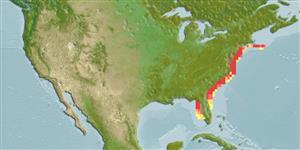Actinopterygii (ray-finned fishes) >
Clupeiformes (Herrings) >
Clupeidae (Herrings, shads, sardines, menhadens) > Alosinae
Etymology: Alosa: Latin, alausa = a fish cited by Ausonius and Latin, halec = pickle, dealing with the Greek word hals = salt; it is also the old Saxon name for shad = "alli" ; 1591 (Ref. 45335).
Environment / Climate / Range
Ecology
Marine; freshwater; brackish; pelagic-neritic; anadromous (Ref. 51243); depth range 5 - 55 m (Ref. 5951). Subtropical, preferred 12°C (Ref. 107945); 41°N - 25°N, 84°W - 60°W (Ref. 188)
Western Atlantic: Cape Breton, Nova Scotia south to the St. John's River, Florida; also in lower parts of rivers.
Size / Weight / Age
Maturity: Lm ? range ? - ? cm
Max length : 40.0 cm SL male/unsexed; (Ref. 7251); common length : 27.5 cm SL male/unsexed; (Ref. 188); max. published weight: 200.00 g (Ref. 7251); max. reported age: 8 years (Ref. 12193)
Dorsal
spines
(total): 0;
Dorsal
soft rays
(total): 15-20;
Anal
spines: 0;
Anal
soft rays: 15 - 21;
Vertebrae: 47 - 53. Moderately compressed, belly with distinct keel of scutes. Upper jaw with a distinct notch; lower jaw rising steeply within mouth; minute teeth present at front of jaws (disappearing with age). Lower gill rakers 41 to 52 (fewer in fishes under 10 cm standard length), slender. Back dark blue, sometimes bluish-grey; a dark spot on shoulder (Ref. 188). Peritoneum black (Ref. 7251). Branchiostegal rays 7 (Ref. 4639).
Form schools and possibly wintering near the bottom and out from the coast, approaching the shore in the late spring. Feed on small fishes, copepods and small shrimps. Spawn in brackish- or freshwaters of rivers, arriving in coastal waters a month or so later than A. pseudoharengus (in April at Chesapeake Bay, apparently when the water is above 70° C and later further north). Eggs are essentially pelagic, demersal in still water (Ref. 4639). Larvae are found in fresh and brackish rivers (Ref. 4639). Juveniles leave fresh and brackish nursery grounds at about 5 cm, migrating downstream (Ref. 4639). Marketed mostly fresh and salted (Ref. 188). Parasites found are acanthocephalan and nematodes (Ref. 37032).
Upriver movement to spawning areas occur in late afternoon or at night (Ref. 4639).
Whitehead, P.J.P., 1985. FAO Species Catalogue. Vol. 7. Clupeoid fishes of the world (suborder Clupeioidei). An annotated and illustrated catalogue of the herrings, sardines, pilchards, sprats, shads, anchovies and wolf-herrings. FAO Fish. Synop. 125(7/1):1-303. Rome: FAO. (Ref. 188)
IUCN Red List Status (Ref. 115185)
CITES (Ref. 94142)
Not Evaluated
Threat to humans
Harmless
Human uses
Fisheries: commercial
Tools
Special reports
Download XML
Internet sources
